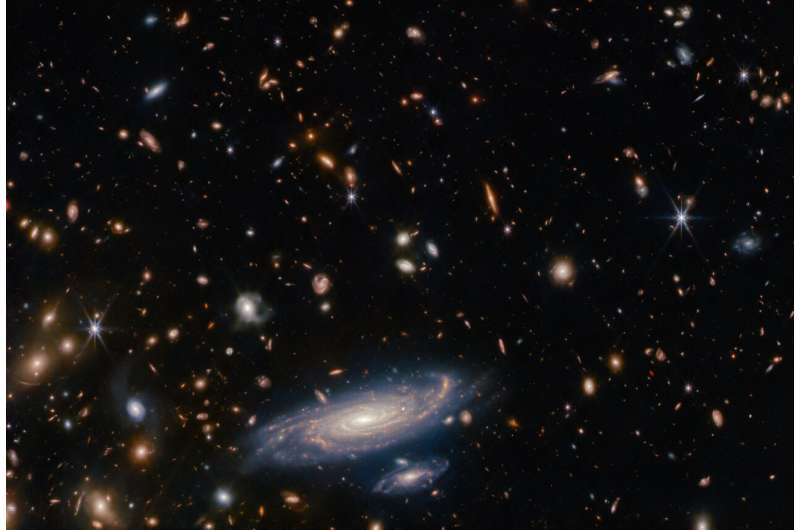This article has been reviewed according to Science X's editorial process and policies. Editors have highlighted the following attributes while ensuring the content's credibility:
fact-checked
trusted source
proofread
Webb captures spiral galaxy LEDA 2046648 among thousands of others

A crowded field of galaxies throngs this image from the NASA/ESA/CSA James Webb Space Telescope, along with bright stars crowned with Webb's signature six-pointed diffraction spikes.
The large spiral galaxy at the base of this image is accompanied by a profusion of smaller, more distant galaxies which range from fully-fledged spirals to mere bright smudges. Named LEDA 2046648, it is situated a little over a billion light-years from Earth, in the constellation Hercules.
One of Webb's principle science goals is to observe distant—and hence ancient—galaxies to understand the details of their formation, evolution, and composition. Webb's keen infrared vision helps the telescope peer back in time, as the light from older, more distant galaxies is redshifted towards infrared wavelengths.
Comparing these galactic fossils to modern galaxies will help astronomers understand how galaxies grew to form the structures we see in the universe today. Webb will also probe the chemical composition of thousands of galaxies to shed light on how heavy elements were formed and built up as galaxies evolved.
To take full advantage of Webb's potential for galaxy archeology, astronomers and engineers must first calibrate the telescope's instruments and systems. Each of Webb's instruments contains a labyrinthine array of mirrors and other optical elements that redirect and focus starlight gathered by Webb's main mirror.
This particular observation was part of the commissioning campaign for Webb's Near-InfraRed Imager and Slitless Spectrograph (NIRISS). As well as performing science in its own right, NIRISS supports parallel observations with Webb's Near-InfraRed Camera (NIRCam). NIRCam captured this galaxy-studded image while NIRISS was observing the white dwarf WD1657+343, a well-studied star. This allows astronomers to interpret and compare data from the two different instruments, and to characterize the performance of NIRISS.
Provided by European Space Agency




















